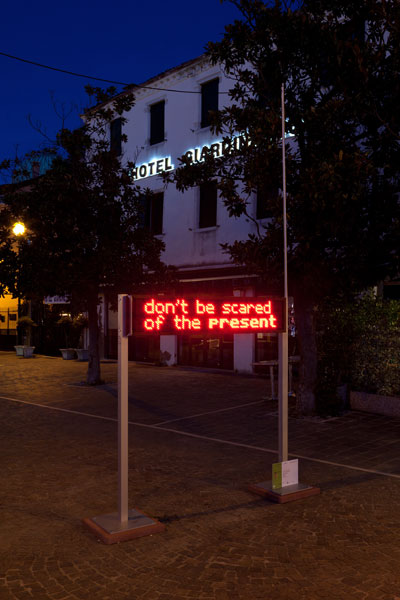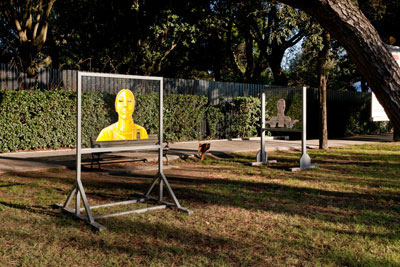GERMANY - E.M.C. COLLARD


The artists of the new generation - and E.M.C. Collard is one of them - have given expression to influences derived from the new trends of Media Art, which leads to apparently more complex forms of Art with minimal technical means.
Around the Sixties, the pioneers of Media Art not only attributed an expressive role to video and to the media, such as television and computers, but considered them real artistic objects, ready made, according to Duchamp’s view. Even in the previous decade they had felt the need to get out of the picture to explore the surrounding space.
E.M.C. Collard picks up these precedents and surpasses them in her performances between nature and symbolism, involving the observer who joins in a game of exploring and conquering the environment, along with the artist. At this point tradition is upset, shown by a rejection of the classically accepted artistic medium, which presents limits when faced with the globality of a new world. Research becomes art, and art becomes exploration. We could say with Laura Panarese that this phase brought about one of the epoch-making evolutions in the history of art, such as perspective in the fifteenth century, Caravaggio’s naturalism in the seventeenth century, Impressionist painting in the nineteenth century and the avant-garde movements of the early twentieth century.
In her research, Collard initially tends towards themes of solidarity, identity and sharing to end up at informative art. Her first experiment was to combine the word with painting. In her personal exhibition at the Swiss Cottage Central Library in London, entitled Words and Pictures, she had considerable success on account of her characteristic dramatic action, which the artist likes to call nanodramatism. Two figures emerge there, as is stressed by the critic Martin Holman in a close analysis of her language: Collard’s works display memory and imagination. The former dominates her drawings for the Divination project, a collective exhibition, the presentation of which travelled for eighteen months through atmospheric spaces from London to Hamburg and Paris. Collard's is an aristocratic art, revealed in the attempt to give a definition to the creative Babel of languages and dialects that overflow from the studios, workshops, galleries, magazines and the slang of the individual artists. The idea of a single dominant language is obsolete, such as social realism, abstract expressionism, or minimalism which at one time incorporated the idea of a cultural process in visual art. Today the preference goes to neo-conceptualism, in multimedia, in the mixture of genres, in globalisation, which at the same time favour and prevent a more widespread reception of art.
Observing the painted works of E.M.C. Collard, Babel can be seen rather in their elaboration than in their definition. She uses colour, the old medium that survives every predicted death in the atelier of committed painters, where paintings are crucified and resurrected on a daily basis: a catharsis experimented by every artist who, like Collard, steeps herself in the idea, processes it, analyses it, contrasts it, deceives it as something of her own, to arrive at her work. Let us consider for example the works Zahnderzeitpasta 3.2.1 and Zahnderzeitpasta Delta Second, paintings which reflect the material nature of the medium, pastel, a delirium of colours and the expressive rhythm of the gesture, tracing a line that winds around itself, snaking and unfolding. Red, white and blue knots slide over the surface that the artist has treated with toothpaste, mixing it with the paints to achieve the effect of a chalky compound. The discordant colour combination gives the canvas a charge of impudence, for its encrustations of semi-phallic-faecal elements, along with a bubbly creative richness.
With all her dreams and experiences, this year E.M.C. Collard comes to Venice, where the port assumes for her, by metonymy, the value of a journey terminus. Swinging between expressionist quotations and figurative connotations, she lands at the place where she is to install her works, a mirror of many collective relationships, a tool for stimulating the genesis of aggregation, able to play an active role in the social dynamics of the island. Her creations represent art at the service of man, a useful and understandable art that guides him in an aesthetic process involving the world and life. First of all she welcomes visitors, passengers on her journey, by creating a system of information on the territory using symbols and notices, that do not alter the real environment, because her art tends to preserve the specific nature, history and memory of the place, the value given to it by the people who frequent it. Collard performs an action of assimilation and adaptation, without imposing any artistic limits on her work, because her art flows freely from the installation to other artistic genres.
Facing the sea we find two of her installations which bring the passenger, in search of a point of reference, to parallel conclusions. The dystopian/utopian message of don’t be scared, a signpost with LEDs that receives the passenger at Lido, apparently similar to the sign of a service station, may be understood as a poetic lullaby for retro generations. "Don’t be scared of past, present, future" says the encouraging warning.
The work Miniscule 2010 processes a self-referential idea that is reinforced in the action projected towards the other in the form of an architectural project for a Venice of the future. It is acrylic paint freely displayed on Plexiglas, in which the monumental bust of a young woman appears, to the eye of the observers, superimposed on the urban view thanks to the transparent support. Figures circulating in the body appear on the opposite side.
We leave the observer to decide whether the female figure or the persons in the building thus conceived are passengers on an imaginary journey: silhouettes in a shadow theatre, statuettes on a music box, frozen to escape the passing of time. On the upper levels are monochrome figurines in choreographic poses, or double-bass players. Others, with a telescope, gaze at the stars through the woman’s eyes, rather like windows open onto the sky. With this installation the artist attempts a leap encompassing astrology and astronomy, a journey into the territories of memory, the science of language. She creates an icon with a strong expressive content, which the receiver can decode thanks to an analysis of the cultural values and the living experience that produce the symbolic message. Miniscule 2010 is the result of a process of communication based on the interaction of six elements: coder, decoder, and message content. Then there is the referent, in our case the metaphor of the journey, the code with which the message is formulated, and lastly the media channel through which it is transferred from the sender to the receiver and vice versa, because there is always a two-way correspondence in a communication process.
Using an elegant and captivating graphic sign, E.M.C. Collard speaks to us of the language expressed by the dancing body, by music and, in an interactive relationship, by groups of people who communicate with one another through speech. In this way the message becomes direct, immediate, it strikes the senses and the instinct, acquires an evident meaning, characterised by simplicity, effectiveness and redundancy. The latter is not excessive, because E.M.C. Collard likes to move discreetly.
Text by Nevia Pizzul - Capello